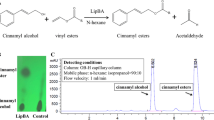Abstract
Four commercially available esterases were screened for their ability to esterify ferulic acid (4-hydroxy-3-methoxy cinnamate). Novozym® 435 was found to be the only one of those screened to convert ferulic acid to ethyl and octyl ferulate at 20 and 14% yields, respectively. The highest percentage conversion was obtained using a 1∶1 mole ratio of alcohol to ferulic acid in stirred batch reactions in anhydrous 2-methyl-2-propanol at 60°C using one equivalent (wt/wt based on ferulic acid) of Novozym 435. Increased water content and a higher alcohol/ethyl ferulate ratio had adverse effects on the lipase-catalyzed esterification. The Novozym 435 activity was tested in less polar solvents (anhydrous toluene and hexane) by monitoring the alcoholysis of ethyl ferulate with 1-octanol, which resulted in a 50% yield of octyl ferulate. The alcoholysis was improved to 83% by applying a 16 mm Hg vacuum for 5 min every 24 h to remove the ethanol co-product. The optimal alcoholysis parameters were applied to the alcoholysis of ethyl ferulate with monoolein and the transesterification with triolein. The transesterification of ethyl ferulate with triolein in anhydrous toluene produced a combined 44% yield of ferulyl monoolein and ferulyl diolein, a 20% greater yield than that obtained for alcoholysis using monoolein. The highest yield, 77%, of ferulyl monoolein and ferulyl diolein was achieved using a threefold excess of neat triolein. The lipase-catalyzed transesterification of ethyl ferulate with triolein appears to be a technically feasible route to ferulyl-substituted acylglycerols, which are potentially useful sunscreen ingredients.
Similar content being viewed by others
References
Willis, W.M., R.W. Lencki, and A.G. Marangoni, Lipid Modification Strategies in the Production of Nutritionally Functional Fats and Oils, Crit. Rev. Food Sci. Nutr. 38:639–674 (1998).
Gunstone, F.D., Movements Towards Tailor-Made Fats, Prog. Lipid Res. 37:277–305 (1998).
Gandhi, N.N., Applications of Lipase, J. Am. Oil Chem. Soc. 74:621–633 (1997).
Schmid, R.D., and R. Verger, Lipases: Interfacial Enzymes with Attractive Applications, Angew. Chem. Int. Ed. 37:1608–1633 (1998).
Fairhurst, D., and M.A. Mitchnick, Particulate Sun Blocks: General Principles, in Sunscreens: Development, Evaluation, and Regulatory Aspects, 2nd edn., edited by J.L. Nicholas, N.A. Shaath, and M.A. Pathak, Marcel Dekker, Inc., New York, 1997, pp. 313–352.
Shaath, N.A., Evolution of Modern Sunscreen Chemicals, Ibid., pp. 3–33.
Shaath, N.A., Quality Control of Sunscreens, Ibid., pp. 657–676.
Wehtje, E., and P. Adlercreutz, Water Activity and Substrate Concentration Effects on Lipase Activity, Biotechnol. Bioeng. 55:798–806 (1997).
Cernia, E., C. Palocci, and S. Soro, The Role of the Reaction Medium in Lipase-Catalyzed Esterifications and Transesterifications, Chem. Phys. Lipids 93:157–168 (1998).
Valiverty, R.H., G.A. Johnston, C.J. Suckling, and P.J. Halling, Solvent Effects on Biocatalysis in Organic Systems: Equilibrium Position and Rates of Lipase-Catalyzed Esterification, Biotechnol. Bioeng. 38:1137–1143 (1991).
Habulin, M., V. Krmelj, and Z. Knez, Synthesis of Oleic Acid Esters Catalyzed by Immobilized Lipase, J. Agric. Food. Chem. 44:338–342 (1996).
Chulalaksananukul, W., J.S. Condoret, P. Delorme, and R.M. Willmot, Kinetic Study of Esterification by Immobilized Lipase in n-Hexane, FEBS Lett. 276:181–184 (1990).
Marty, A., W. Chulalaksananukul, R.M. Willmot, and J.S. Condoret, Kinetics of Lipase Catalyzed Esterification in Supercritical CO2, Biotechnol. Bioeng. 39:273–280 (1992).
Otto, R.T., U.T. Bornscheuer, H. Scheib, J. Pleiss, C. Sydatk, and R.D. Schmid, Lipase-Catalyzed Esterification of Unusual Substrates: Synthesis of Glucuronic Acid and Ascorbic Acid (vitamin C) Esters, Biotechnol. Lett. 20:1091–1094 (1998).
Neff, W.E., and W.C. Byrdwell, Characterization of Model Triacylglycerol (triolein, trilinolein, and trilinolenin) Autooxidation Products via High-Performance Liquid Chromatography Coupled with Atmospheric Pressure Chemical Ionization Mass Spectroscopy, J. Chromatogr. A 818:169–186 (1998).
Author information
Authors and Affiliations
Corresponding author
About this article
Cite this article
Compton, D.L., Laszlo, J.A. & Berhow, M.A. Lipase-catalyzed synthesis of ferulate esters. J Amer Oil Chem Soc 77, 513–519 (2000). https://doi.org/10.1007/s11746-000-0082-9
Received:
Accepted:
Issue Date:
DOI: https://doi.org/10.1007/s11746-000-0082-9




